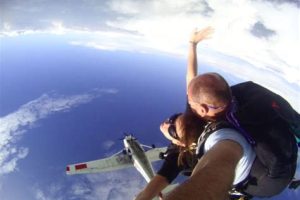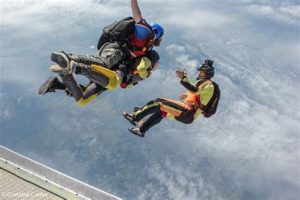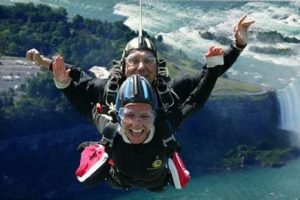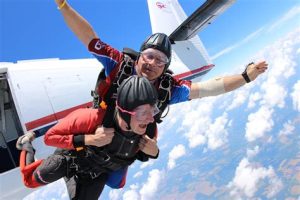Table of Contents
Tandem skydiving is an exhilarating adventure, but it’s important to be aware of the risks involved. This article explores the potential dangers associated with tandem skydiving, including equipment malfunctions and adverse weather conditions. Gain insight into safety measures and precautions to ensure a safe and enjoyable experience.
Tandem skydiving is an exhilarating adventure that offers a unique perspective of the world from thousands of feet above ground. However, before taking the plunge, it is important to be aware of the risks involved in this thrilling activity. While tandem skydiving is generally considered safe when performed under proper supervision, there are certain factors that can increase the level of danger. Therefore, it is crucial to understand these risks and take necessary precautions to ensure a safe and memorable experience.
Introduction
Tandem skydiving is an exhilarating adventure that allows individuals to experience the thrill of freefalling from great heights while securely harnessed to a professional instructor. While it offers an incredible adrenaline rush and breathtaking views, it’s essential to be aware of the potential risks involved in this extreme sport.
Equipment Failure
One of the primary risks associated with tandem skydiving is equipment failure. As with any mechanical apparatus, there is always the possibility of malfunction. From parachute malfunctions to harness failures, these incidents can be rare but catastrophic if they occur. It is crucial to ensure that the gear used is regularly inspected and maintained by professionals to minimize the risk of such failures.
Instructor Error
The expertise and experience of the tandem skydiving instructor play a vital role in ensuring a safe jump. However, human error can still occur. Mistakes made by the instructor during the jump or landing process can lead to accidents and injuries. It is crucial to choose a reputable skydiving center with well-trained instructors who prioritize safety measures.
Weather Conditions
Weather conditions significantly impact the safety of a tandem skydiving experience. High winds, storms, or other adverse weather patterns can make it unsafe to jump. Operating in unfavorable weather conditions increases the risk of accidents, parachute collapses, or uncontrolled landings. Always trust the judgment of the instructors and be prepared for potential delays or rescheduling due to weather concerns.
Physical Injury
The physical demands of tandem skydiving can put stress on the body, particularly during the landing phase. Improper technique or landing position can result in sprains, fractures, or other injuries. It is crucial to listen carefully to the instructor’s guidance on landing technique and follow their instructions precisely to minimize the risk of injury.
Health Concerns
Tandem skydiving requires a certain level of physical fitness. Individuals with pre-existing health conditions such as heart problems, high blood pressure, or respiratory issues may face increased risks during the jump. It is essential to consult with a medical professional beforehand and disclose any health concerns to the skydiving center to ensure your safety.
Emotional Impact
Tandem skydiving can evoke intense emotions, including fear, anxiety, and even panic. The psychological impact of jumping from an aircraft at high altitude can be overwhelming for some individuals. It is essential to be mentally prepared and understand your own limits before attempting a skydive. Communicate openly with instructors about any fears or concerns you may have.
Adverse Reactions
Some individuals may experience adverse reactions during the freefall or after landing, such as dizziness, nausea, or disorientation. These reactions can be triggered by the body’s response to extreme sensations and adrenaline release. While these symptoms are typically temporary, they can affect the overall experience and potentially increase the risk of accidents. Inform your instructor immediately if you experience any adverse reactions.
Unpredictable Situations
Despite proper planning and preparation, there are still elements of unpredictability in tandem skydiving. Sudden changes in wind patterns, unexpected obstacles during landing, or other unforeseen circumstances can lead to accidents or injuries. Maintaining situational awareness, listening to your instructor, and following their guidance can help mitigate risks in such situations.
Parachute Landing Falls
Parachute landing falls, also known as PLFs, are techniques used to reduce the impact while landing. However, incorrect execution or poor timing can result in injuries. It is crucial to practice PLFs during training sessions and follow the instructor’s guidance carefully to minimize the risk of sprains or fractures upon landing.
Conclusion
Tandem skydiving involves inherent risks that should not be taken lightly. While accidents and incidents are relatively rare, it is crucial to be aware of the potential dangers and take necessary precautions. Choose a reputable skydiving center with experienced instructors, follow safety procedures diligently, and communicate openly with professionals to ensure a safe and unforgettable tandem skydiving experience.
Tandem Skydiving Risks: Instructions and Warnings for a Safe Experience
Preparing for Takeoff: Proceed with Caution
Before embarking on a tandem skydiving adventure, it is crucial to ensure that you are in good physical health. Inform your tandem skydiving instructor of any pre-existing medical conditions that may affect your ability to safely participate in the activity. Additionally, take the time to familiarize yourself with the potential risks associated with skydiving, such as motion sickness, disorientation, and temporary hearing loss due to altitude changes.
Equipment Inspection: Safety First
Prior to boarding the aircraft, your instructor will conduct a thorough inspection of all the skydiving equipment, including parachutes, harnesses, and reserve systems. It is of utmost importance to be attentive during this process. Carefully listen to any instructions provided by your instructor regarding the correct usage and handling of the equipment. This step ensures that you are properly equipped and minimizes the potential risks associated with faulty equipment.
The Freefall Experience: Manage Your Expectations
It is important to understand that during the initial moments of freefall, you might experience physical discomfort due to the change in air pressure. Be prepared for sensations like shortness of breath and facial pressure, which are generally temporary and subside as you adjust to the new environment. Stay calm and follow your instructor’s guidance to maintain a stable body position, ensuring a safer and more enjoyable experience.
Parachute Activation: Rely on the Experts
One of the most critical aspects of tandem skydiving is leaving the responsibility of activating the parachute solely to your instructor. They are trained professionals who possess the necessary skills to handle emergency situations effectively. Trust their expertise and resist the urge to intervene or attempt to activate the parachute yourself. By following their instructions, you contribute to a safer descent.
Emergency Procedures: Know What to Do
Prior to the jump, it is essential to familiarize yourself with the emergency procedures outlined by your instructor. These procedures may include techniques for handling equipment malfunctions, emergency landings, and injury prevention. Stay attentive during the briefing and do not hesitate to ask any necessary clarifying questions. Being aware of how to handle potential emergencies will ensure that you can respond appropriately in unexpected situations.
Weather Conditions: Consider Safety First
While the desire to skydive may be strong, it is vital to prioritize safety above all else. Understand that weather conditions significantly impact the safety of your jump. Follow the guidance of your instructor and be prepared to reschedule if necessary due to adverse weather conditions such as high winds, rain, or storms. Remember that your safety is paramount, and postponing the jump ensures a more secure and enjoyable experience.
Landing: Listen and Follow Instructions
As you approach the landing zone, maintain a flexible body posture and listen attentively to the instructions given by your instructor. They will guide you on how to execute a safe and controlled landing. It is crucial to follow their guidance and resist the temptation to change the landing location or choose your own landing technique. By adhering to their instructions, you minimize the risk of injuries and ensure a smooth landing.
Post-Jump Evaluation: Communicate Any Concerns
After landing, take a moment to evaluate your overall well-being. If you experience any physical discomfort, dizziness, or pain, communicate it to your instructor immediately. Providing feedback about your experience is essential as it helps the tandem skydiving facility improve safety measures if necessary. By sharing your concerns, you contribute to a safer experience for future participants.
When it comes to tandem skydiving, it is important to be aware of the potential risks involved. While the experience can be exhilarating and unforgettable, it is crucial to prioritize safety and follow all instructions provided to minimize any dangers. Here are some key points to consider:
-
Arrive prepared: Make sure you arrive at the skydiving center with a clear mind and without any substance impairments. It is crucial to be in a good physical and mental condition to ensure your safety.
-
Listen attentively: Pay close attention to the instructions given by your tandem instructor. They are trained professionals who will guide you through the entire process. Follow their guidance carefully to ensure a safe and enjoyable experience.
-
Wear appropriate gear: Always wear the provided safety equipment, including the jumpsuit, helmet, and goggles. These items are designed to protect you during the jump and landing. Check that they fit properly before you start.
-
Understand the risks: Although tandem skydiving is generally safe, there are inherent risks involved in any extreme sport. You should be aware that accidents can happen even with proper preparation and precautions. However, these risks are minimized with the help of experienced instructors and well-maintained equipment.
-
Follow safety protocols: Adhere to all safety protocols and procedures outlined by your instructor. These may include body positions during the jump, communication signals, and landing techniques. Remember, your instructor is there to ensure your safety, so it is important to trust their expertise.
-
Weather considerations: Skydiving is highly dependent on weather conditions. Always follow the advice of your instructor regarding weather-related uncertainties. If conditions are not suitable, be prepared to reschedule your jump for another day.
-
Age and health restrictions: Some skydiving centers may have age and health restrictions due to the physical demands of the activity. Make sure you meet the necessary requirements before booking your tandem skydive.
-
Be mentally prepared: Tandem skydiving can be an intense experience, especially for first-timers. It is important to mentally prepare yourself for the adrenaline rush and the feeling of freefall. Embrace the excitement, but also stay calm and focused throughout the entire process.
Remember, tandem skydiving risks can be minimized by following instructions, trusting your instructor, and being aware of your own limitations. By taking these precautions, you can fully enjoy the thrill of skydiving while ensuring your safety.
Thank you for taking the time to read our blog post about tandem skydiving risks. We hope that you have found the information provided valuable and insightful. As with any extreme sport, tandem skydiving carries certain risks that should be taken into consideration before embarking on this thrilling adventure. In this closing message, we would like to summarize the main points discussed in the article and provide some final thoughts on the topic.
Firstly, it is important to acknowledge that while tandem skydiving can be an exhilarating experience, there are inherent risks involved. These risks include potential equipment failures, weather conditions, and human error. Despite strict safety regulations and thorough training programs, accidents can still occur. However, it is worth noting that the overall risk of a fatal accident in tandem skydiving is relatively low when compared to other activities such as driving or even riding a bicycle.
Secondly, it is crucial to choose a reputable and experienced skydiving center for your tandem jump. Research the facility thoroughly, read reviews, and ensure that they comply with all necessary safety regulations. By selecting a professional and well-established skydiving center, you can significantly minimize the risks associated with tandem skydiving. Remember to ask questions, seek clarification, and voice any concerns you may have before making your reservation.
In conclusion, tandem skydiving undoubtedly poses risks, but with proper precautions and by choosing a trustworthy skydiving center, you can mitigate these risks to a great extent. Remember that skydiving is an extreme sport, and it is essential to evaluate your own physical and mental readiness before taking part. If you have any pre-existing medical conditions or concerns, consult with your healthcare provider before making the decision to skydive. Ultimately, the decision to engage in tandem skydiving rests with you, and we hope that this blog post has provided you with the necessary information to make an informed choice.
Thank you once again for visiting our blog and for your interest in tandem skydiving risks. We encourage you to continue exploring our website for more informative articles on various topics related to adventure sports and outdoor activities. Stay safe and enjoy your future endeavors!
.
When it comes to tandem skydiving, many people have questions about the associated risks. Below are some of the most commonly asked questions and their corresponding answers:
1. Is tandem skydiving safe?
Tandem skydiving is generally considered safe when conducted by experienced professionals who follow strict safety protocols. The risk of injury or fatality is relatively low compared to other adventure sports.
2. What are the main risks involved in tandem skydiving?
The main risks associated with tandem skydiving include parachute malfunctions, injuries upon landing, and the potential for collisions with other skydivers or objects in the air. However, these risks can be mitigated through proper training, equipment checks, and adherence to safety guidelines.
3. Can I have a medical condition that prevents me from tandem skydiving?
Individuals with certain medical conditions may be advised against tandem skydiving due to the potential risks involved. It’s crucial to consult with a doctor beforehand and inform the skydiving center about any medical conditions you have to ensure your safety.
4. How often do parachute failures occur during tandem skydives?
Parachute failures during tandem skydives are extremely rare, thanks to rigorous equipment maintenance and regular inspections. The chances of experiencing a parachute malfunction are minimal, but skydiving instructors are trained to handle such situations in the unlikely event they occur.
5. What precautions can I take to minimize the risks of tandem skydiving?
To minimize the risks associated with tandem skydiving, follow these precautions:
- Choose a reputable skydiving center with experienced instructors and good safety records.
- Follow all instructions provided by the instructor during the pre-jump briefing.
- Ensure your harness and gear are properly fitted before the jump.
- Inform your instructor about any concerns or medical conditions you may have.
- Stay calm during the jump and follow the instructor’s guidance throughout the experience.
6. Is there an age limit for tandem skydiving?
The age limit for tandem skydiving varies between countries and skydiving centers. Generally, participants must be at least 18 years old or have written consent from a parent or guardian. Some centers may have upper age limits due to health considerations.
7. What happens if bad weather conditions arise during my scheduled tandem skydive?
If adverse weather conditions such as high winds or stormy weather occur, the skydiving center will likely reschedule your jump for a safer time. Safety is paramount, and skydiving operations prioritize the well-being of their customers.
Remember, while there are risks associated with tandem skydiving, millions of people have safely enjoyed this exhilarating adventure. By choosing a reputable skydiving center, following instructions, and taking necessary precautions, you can minimize these risks and have a thrilling, memorable experience.






